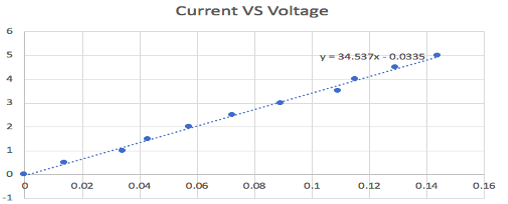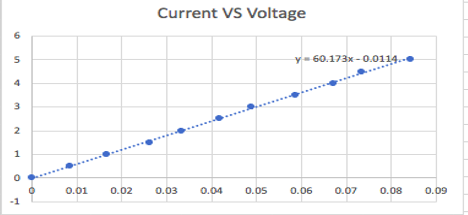As the potential across the resistor increased, the current through the resistor increased. If the change in current is proportional to the voltage, the data should be in a straight line and it should go through zero. In these two examples how close is the y-intercept to zero? Is there a proportional relationship between voltage and current? If so, write the equation for each run in the form potential = constantcurrent. (Use a numerical value for the constant.)
As the potential across the resistor increased, the current through the resistor increased. If the change in current is proportional to the voltage, the data should be in a straight line and it should go through zero. In these two examples how close is the y-intercept to zero? Is there a proportional relationship between voltage and current? If so, write the equation for each run in the form potential = constantcurrent. (Use a numerical value for the constant.)
College Physics
1st Edition
ISBN:9781938168000
Author:Paul Peter Urone, Roger Hinrichs
Publisher:Paul Peter Urone, Roger Hinrichs
Chapter20: Electric Current, Resistance, And Ohm's Law
Section: Chapter Questions
Problem 85PE: (a) Haw much power is dissipated in a short circuit of 240-V AC through a resistance of 0.250 ? (b)...
Related questions
Concept explainers
Ohm's law
Ohm’s law is a prominent concept in physics and electronics. It gives the relation between the current and the voltage. It is used to analyze and construct electrical circuits. Ohm's law states that the voltage across a conductor is directly proportional to the current flowing through it.
Path of Least Resistance
In a series of alternate pathways, the direction of least resistance is the actual or metaphorical route that offers the least resistance to forwarding motion by a given individual or body.
Question
ANALYSIS
- As the potential across the resistor increased, the current through the resistor increased. If the change in current is proportional to the voltage, the data should be in a straight line and it should go through zero. In these two examples how close is the y-intercept to zero? Is there a proportional relationship between voltage and current? If so, write the equation for each run in the form potential = constantcurrent. (Use a numerical value for the constant.)
- Compare the constant in each of the above equations to the resistance of each resistor.
- Resistance, R, is defined using R = V/I where V is the potential across a resistor, and I is the current. R is measured in ohms (), where 1 = 1 V/A. The constant you determined in each equation should be similar to the resistance of each resistor. However, resistors are manufactured such that their actual value is within a tolerance. For most resistors used in this lab, the tolerance is 5% or 10%. Check with your instructor to determine the tolerance of the resistors you are using. Calculate the range of values for each resistor. Does the constant in each equation fit within the appropriate range of values for each resistor?
- Do your resistors follow Ohm’s law? Base your answer on your experimental data.

Transcribed Image Text:Current VS Voltage
6
y= 34.537x - 0.0335.
4
3
1
0.02
0.04
0.06
0.08
0.1
0.12
0.14
0.16
-1

Transcribed Image Text:Current VS Voltage
6
y- 60.173x-0.0114.-
3.
2
1
0.01
0.02
0.03
0.04
0.05
0.06
0.07
0.08
0.09
-1
Expert Solution
This question has been solved!
Explore an expertly crafted, step-by-step solution for a thorough understanding of key concepts.
This is a popular solution!
Trending now
This is a popular solution!
Step by step
Solved in 3 steps

Knowledge Booster
Learn more about
Need a deep-dive on the concept behind this application? Look no further. Learn more about this topic, physics and related others by exploring similar questions and additional content below.Recommended textbooks for you

College Physics
Physics
ISBN:
9781938168000
Author:
Paul Peter Urone, Roger Hinrichs
Publisher:
OpenStax College


Glencoe Physics: Principles and Problems, Student…
Physics
ISBN:
9780078807213
Author:
Paul W. Zitzewitz
Publisher:
Glencoe/McGraw-Hill

College Physics
Physics
ISBN:
9781938168000
Author:
Paul Peter Urone, Roger Hinrichs
Publisher:
OpenStax College


Glencoe Physics: Principles and Problems, Student…
Physics
ISBN:
9780078807213
Author:
Paul W. Zitzewitz
Publisher:
Glencoe/McGraw-Hill

Physics for Scientists and Engineers, Technology …
Physics
ISBN:
9781305116399
Author:
Raymond A. Serway, John W. Jewett
Publisher:
Cengage Learning

Physics for Scientists and Engineers: Foundations…
Physics
ISBN:
9781133939146
Author:
Katz, Debora M.
Publisher:
Cengage Learning

College Physics
Physics
ISBN:
9781285737027
Author:
Raymond A. Serway, Chris Vuille
Publisher:
Cengage Learning